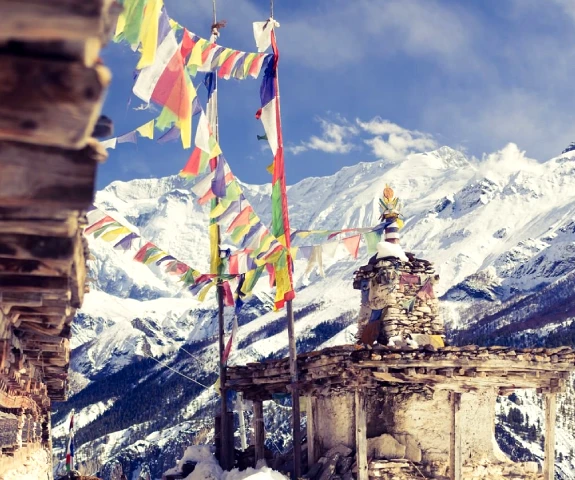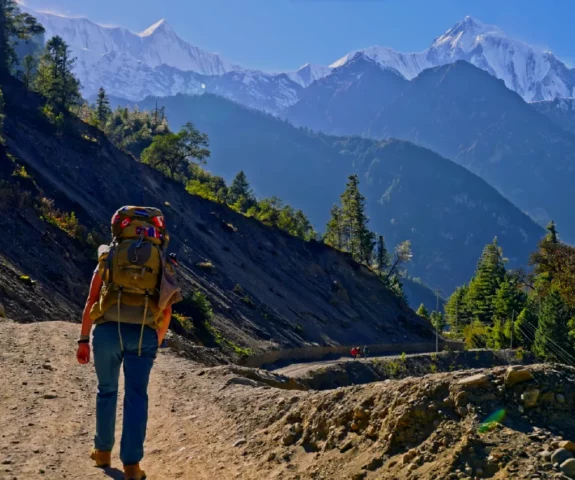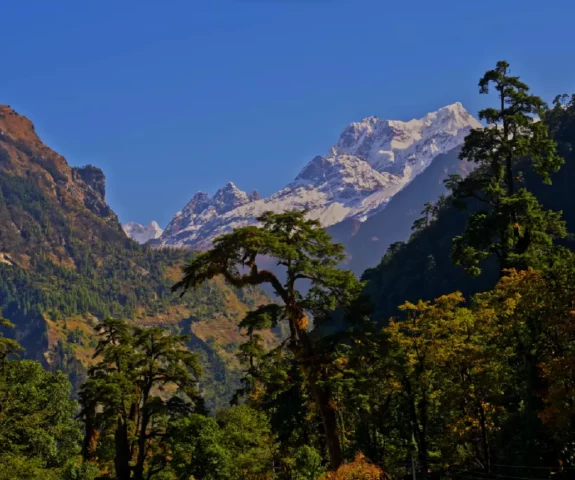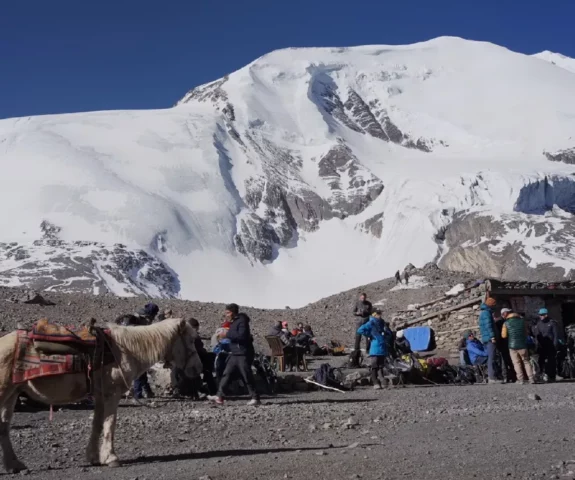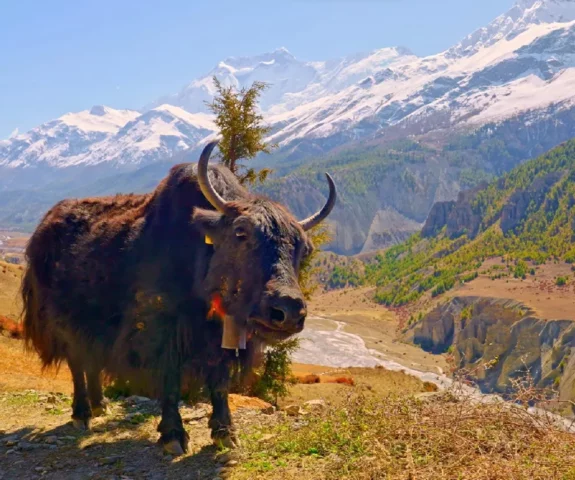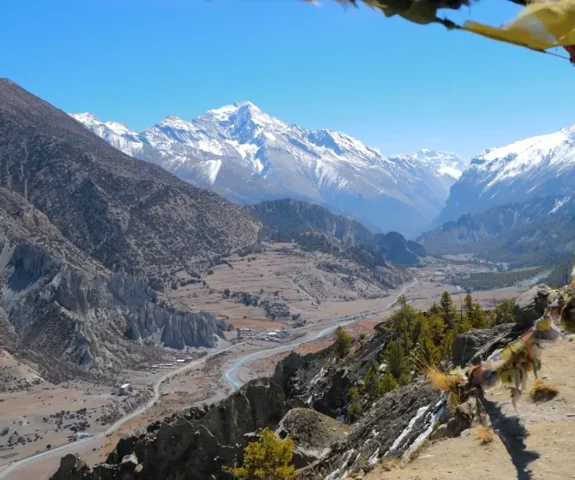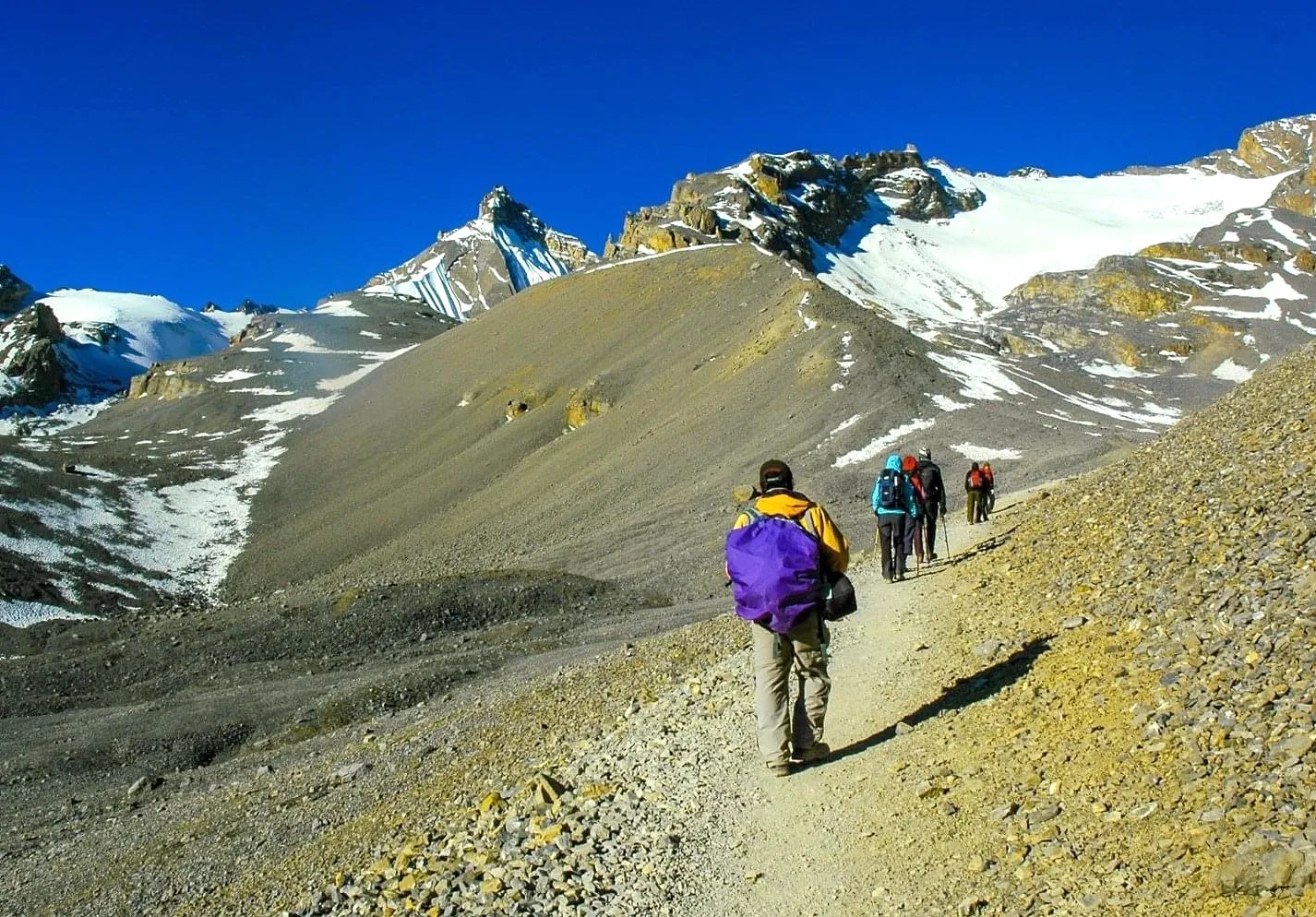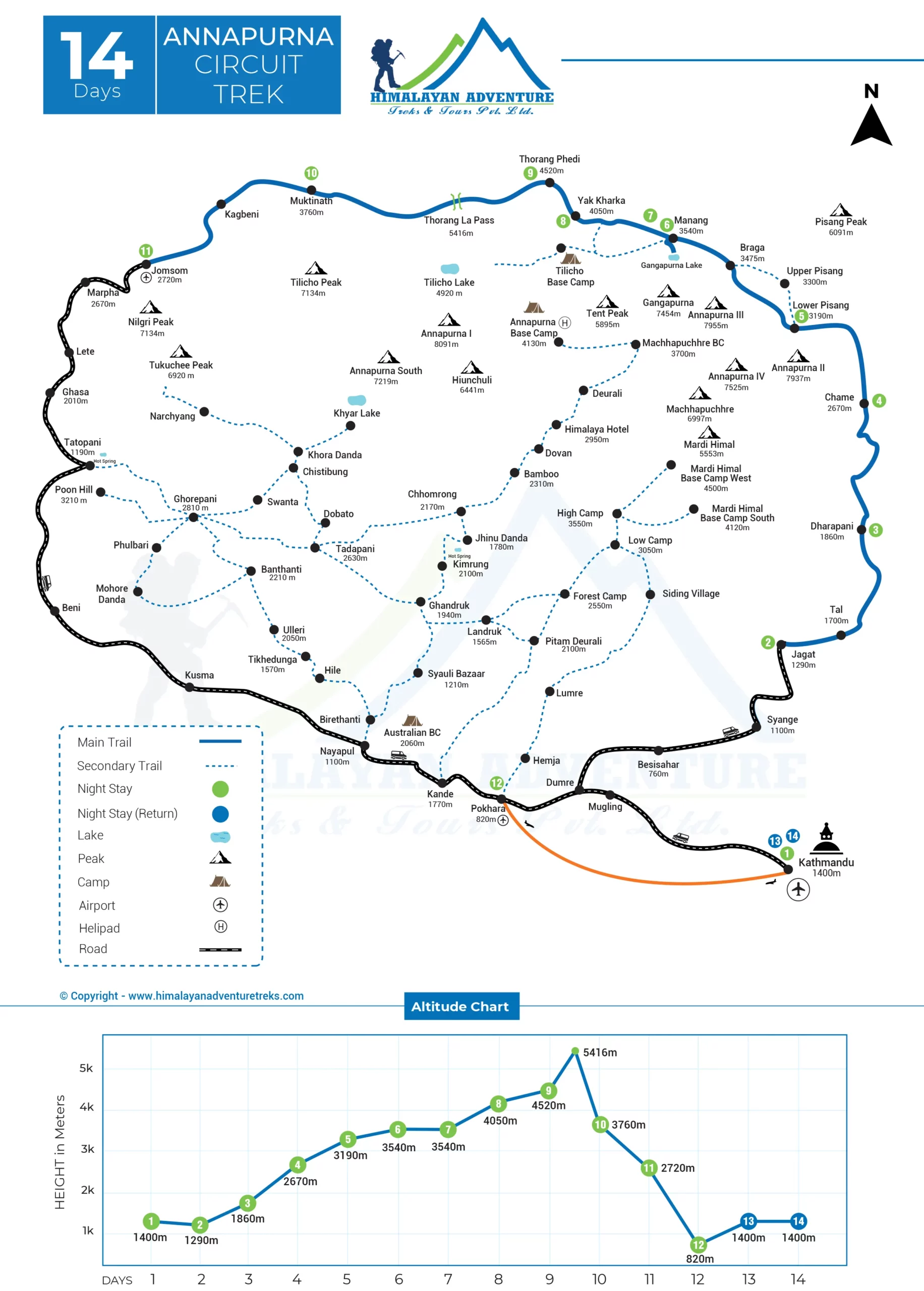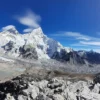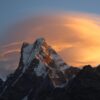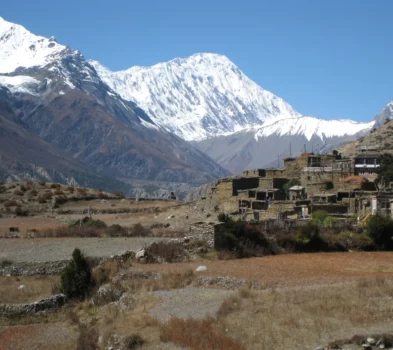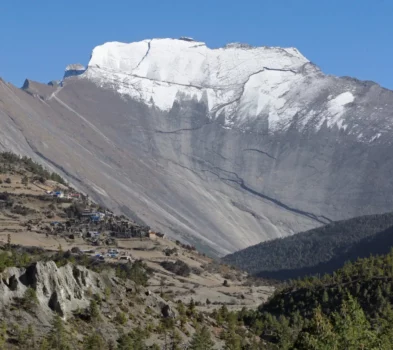Duration
14 DaysAnnapurna Circuit Trek 14 Days
Trip Grade
ModerateGroup Size
1 - 16 PeopleMax Altitude
4,450m. / 14,600ft.Best Season
Feb- May/ Sept- NovActivity
Trekking & HikingMeals
Breakfast, Lunch & DinnerAccommodation
Hotels & TeahousesTransportation
Private Vehicle & BusTrip Customization
On request (click here)Highlights of Annapurna Circuit Trek 14 Days
- A day in the lively metropolis of Kathmandu with its deep-rooted traditions and temples, monasteries, and palaces
- A lively thrilling crossing of the mountain roads
- Take the challenge of the Thorong La Pass and admire the attractive features of the Lamjung Himal, Annapurna I, Dhaulagiri, Fishtail, Hiunchuli, Manaslu, and Nilgiri
- A diverse route to Muktinath and absorb its spiritual vibe
- A journey through the lovely lower Mustang villages of Kagbeni and Jomsom
- A day in Pokhara- the tourist capital and the Switzerland of Nepal
- A journey through the variants of terrain progressing from dense jungles to alpine pastures
- Meet the sincere Magars and Gurungs
Trip Introduction
Did you say you need Great Trekking? We heard you, and so we are endeavoring to take you to the mesmerizing Annapurna Circuit Trek- 14 days, one of the most sought-after, iconic, and beautiful circuits of the world that is dreamed of by all hiking lovers in the Annapurna Region.
Our Annapurna circuit trek itinerary will last 14 days and this time too, there will be no cars, no jeeps, and no any four-wheels. Just us, our legs, the Sherpa, and our only goal, to see and admire all the Himalayas and landscape on the circuit.
The Annapurna is the name of the whole mountain range that lies in the north-central expanse of Nepal. The name Annapurna comes from the celebrated goddess of nourishment herself. The mountain range is home to the tenth most prominent peak on the planet: the great Annapurna 1 elevated to 8091 m.
Accompanying this giant are the 13 other 7000 m peaks and 16 more above 6000 m. The further circuit route is sculpted beautifully by the gorges of the Marshyangdi and Kali Gandaki rivers, while enchanting Tibetan Buddhist terrain decorates it further from Pisang towards Mustang.
The lively musical Magars and Gurungs renowned for their diligence, bravery, and deep-rooted Tibetan Buddhist traditions dwell in the region. And, you will get to explore and feel all this beauty and heritage in our Annapurna circuit trek 14 days long journey.
Thus, you will have worlds to explore, the people to know, the complex realities to confront, and perhaps the chance to discover something about yourself.
Your amazing journey commences from Kathmandu which will be a memorable experience in itself. Temple, altars Gompas, and markets welcome you on your first day after which you will take a long drive to Jagat.
Your path will then take you through various picturesque settlements of the Manang Valley, where the promise of touching the sky with a finger is kept.
Finally, you will make it to the authentic Manang Village, a village stuck in the past, full of abandoned buildings, forts, and monasteries, and whose inhabitants have a contagious smile.
Your journey continues as you move on to conquer the inevitable 5416 m high Pass of Thorong La that not only tests your determination but in return will also give you an extraordinary visual of the great Himalayan landscape including Lamjung Himal (6983 m), Annapurna I, Dhaulagiri (8167 m), Fishtail (6993 m), Hiunchuli (6441 m), Manaslu (8163 m), and Nilgiri.
As you descend, your Annapurna circuit trek 14 days will lead you to the hallowed land of Muktinath, where Buddhists and Hindus worship the same deity in their own unique ways. Bathing in the 108 natural springs of this sacred temple complex is believed to relieve you of all sins.
Your adventure will then continue to Mustang as you make your way to Jomsom via Kagbeni. The desolate Mars-like terrain starts to gradually transform into lush green hills as you prepare to return to Kathmandu via the serene Pokhara.
Truly, this Annapurna circuit trek 14 days will help you immortalize the majestic mountain peaks of the Annapurna chain, the culture, the nature, and the landscape in your own unique way.
Join us if you want to get all this experience within a brief time of a fortnight. It is open to all who possess the health and fitness, who have the skill and determination. Remember, this is not a mountaineering journey but a sensational trekking route that is best enjoyed during the transitional seasons of autumn and spring.
Outline Itinerary of Annapurna Circuit Trek 14 Days
Day 01: Arrival at Kathmandu Airport (1400 m).
Day 02: Drive from Kathmandu to Jagat (1290 m) via Besisahar.
Day 03: Trek from Jagat to Dharapani (1860 m).
Day 04: Trek from Dharapani to Chame (2650 m).
Day 05: Trek from Chame to Pisang (3250 m).
Day 06: Trek from Pisang to Manang (3519 m).
Day 07: Rest day at Manang and visit Gangapurna Glacier Lake (3540 m).
Day 08: Trek from Manang to Yak Kharka (4020 m).
Day 09: Trek from Yak Kharka to Thorong Phedi (4450 m).
Day 10: Trek from Throng Phedi to Muktinath (3,760 m) via Thorang La Pass (5416 m).
Day 11: Trek from Muktinath to Jomsom (2743 m) via Kagbeni.
Day 12: Drive from Jomsom to Pokhara (822 m).
Day 13: Drive from Pokhara to Kathmandu (1300 m).
Day 14: Departure to Kathmandu Airport.
Our guests sharing their experiences (Photo/Video Gallery)
Detail itinerary of Annapurna Circuit Trek 14 Days
Day 01: Arrival at Kathmandu Airport (1400 m).
Hello and Welcome! After you leave the TIA gate, you will find our representative to receive you. After assistance with your luggage, he will take you through the heavy traffic of Kathmandu towards your hotel in Kathmandu we have chosen for your comfort.
After settling in, you can venture to Thamel and collect the essentials you may be needing for the Annapurna Circuit trek. In the evening, our guide will gather all the trekkers for a briefing about our Annapurna Circuit itinerary.
Please rest early and recover from jet lag as we have a long and exciting driving journey ahead of us in the early morning tomorrow.
Activity: Airport Pickup, 30 min
Max. Altitude: 1,400m/4,593ft. Kathmandu
Accommodation: Hotel
Day 02: Drive from Kathmandu to Jagat (1290 m) via Besisahar.
Early morning, we are set to depart from Kathmandu by bus towards Jagat, our first mountain village for an overnight stay. The wide Kathmandu road will take us outside through Kalanki and Thankot after which the expansive Prithvi Highway will take us further passing by the rolling green hills and hugged by the enchanting Annapurna, Langtang, and Lamjung Himals.
After we pass the small Dure town, we will take the scenic road that follows the Marshyangdi River to reach Besi Sahar. Here, we will leave the bus and take a break for some stretching.
We will then board the local sharing jeep to reach Jagat which lies perfectly cradled by the huge frame of the Annapurna and Manaslu range.
Activity: Drive, 7-8 hours
Max. Altitude: 1,290m/4,232ft. Jagat
Meal: Breakfast, Lunch & Dinner
Accommodation: Teahouse
Day 03: Trek from Jagat to Dharapani (1860 m).
Here comes our inaugural day of hiking as we set forth towards Dharapani. From Jagat, that path will gently ascend along the steady hilltop of Bahun Danda.
We will keep ascending towards Chamje from where the trail will elegantly rise through the serpentine mountain path running beside the marvelous current of the Marshyangdi River till we reach Tal.
Now the rich thickets of rhododendrons and bamboo will slowly usher us into the enchanting territory of the Manang Valley. The terrain from here transitions into typical Tibetan form- rugged, dusty, and dry as we pass through Karte.
Now, we will climb a series of stone steps which will ultimately lead us to Dharapani.
Activity: Trek, 5-6 hours
Max. Altitude: 1,860m/6,102ft. Dharapani
Meal: Breakfast, Lunch & Dinner
Accommodation: Teahouse
Day 04: Trek from Dharapani to Chame (2650 m).
From today, our journey will take us to the west, and after walking for around 60 minutes or so, we will arrive at the lovely town of Bagarchhap (2160 m).
Surrounded by peach orchards, this lively town offers a stunning prolific view of Lamjung and Annapurna II. Marching forward, we will encounter two more charming hamlets, Danakyu and Timang.
Now, hiking through the scattered treeline, we will cross a few bridges and walk past some marvelous waterfalls till we reach Lata Marang (2400 m). A gentle 200 m uprising trail will take us to Koto lying beside the Phu Khola.
Another gentle uprising path will then lead us to Chame, the endearing large and very busy Tibetan Village of the Manang Valley.
Activity: Trek, 5-6 hours
Max. Altitude: 2,650m/8,694ft. Chame
Meal: Breakfast, Lunch & Dinner
Accommodation: Teahouse
Day 05: Trek from Chame to Pisang (3250 m).
We leave Chame and keep on walking through the fairy tale land. After around two hours, we will be in Bhratang Village where we can still see the remnants of old refugee camps.
We will come across a quaint bridge which will forward us toward the uprising trail through the forest to imposing 1400 m high Paungdi Danda rock slab of Dhukur Pokhari.
From here, the landscape takes the dramatic form and we are now in the heart of the Manang Valley. The Tibetan landscape will truly enchant us as we make our way for around an hour and a half to arrive at Lower Pisang.
It is not as much interesting, we can see a few houses here and there as we push ourselves for a few more hours till we make it to the Upper Pisang- more remarkable and larger than its lower counterpart.
The expansive fields of potato, and buckwheat and the large courtyards of the residential house decorate this town along with the incredible frames of the massive Annapurna II, IV, and Pisang Peak.
Activity: Trek, 5-6 hours
Max. Altitude: 3,250m/10,663ft. Pisang
Meal: Breakfast, Lunch & Dinner
Accommodation: Teahouse
Day 06: Trek from Pisang to Manang (3519 m).
We will leave Pisang early and journey along the series of Mani Walls inscribed with sacred Buddhist text. The path ahead will dramatically rise and take us around 350 m high of Pisang to the Village of Ghyaru (3670 m).
It is more remarkable than Pisang with its fortress-like art and colorful homes. But the most wonderful is the huge Himalayas of Lamjung, Gangapurna, Tilicho, Annapurna II, III, and IV just staring at us at the horizon.
The journey from here will be effortless as we proceed towards Ngawal (3657 m). Suddenly the striking features of the Chulu range will appear in front of us. Now, we will walk down sharply and join the path to the main route that leads to Bragha (3450 m).
The 5-century-old monastery of this small village is worth exploring. Within half an hour, we will be in the true Manang Village, a perfect spot for its extraordinary beauty and our optimal acclimatization.
Activity: Trek, 5-6 hours
Max. Altitude: 3,519m/11,545ft. Manang
Meal: Breakfast, Lunch & Dinner
Accommodation: Teahouse
Day 07: Rest day at Manang and visit Gangapurna Glacier Lake (3540 m).
We will have our day reposing at Manang for our best acclimatization. The village itself although at a high elevation is situated on the flat sandy terrain which gives the enviable view of the spectacular Gangapurna.
To see the mountain and its glacier kissed by the first morning rays, we will go to the 4130 m high Chongkor lookout point aka Bodzo Gompa. Then after we had our lunch, we will hike for around 30 minutes to reach the peaceful Gangapurna Glacier lake that shimmers beneath the glacier.
Later in the afternoon, we may also listen to the information related to the high altitude in the local health care center of the village.
Activity: Hike, 4-5 hours
Max. Altitude: 3,540m/11,614ft. Manang
Meal: Breakfast, Lunch & Dinner
Accommodation: Teahouse
Day 08: Trek from Manang to Yak Kharka (4020 m).
Not long after leaving Manang, we will be climbing the trail that will direct us to Tengi Manang (3650 m). now, our climbing will be much harder as the sheer trail goes on inclining as we make our way to 3890 m high Ghunsang Village.
Turning north, we will journey past several Mani walls and chortens as we gradually see the highland green pasture of Yak Kharka. The place is wonderfully situated along the wild highlands of Nepal with few lodges where we will rest for the evening.
Activity: Trek, 3-4 hours
Max. Altitude: 4,020m/13,189ft. Yak Kharka
Meal: Breakfast, Lunch & Dinner
Accommodation: Teahouse
Day 09: Trek from Yak Kharka to Thorong Phedi (4450 m).
We will have a splendid short journey today to take our time to adapt much better to the heights of the Annapurna region. From Yak Kharka, we will set forth towards the Upper Yak Kharka and then surge to Letder.
Now, a slender trail will take us to the bridge spanning over the beautiful Thorong River. The icy walls of the imposing Sagang, Gundang, and Khatungkan can be seen beautifully en route.
Now, scaling the uprising trail, we will finally be at Thorong Phedi – a remote yet beautiful setting for the night to await the massive crossing of the Thorong La Pass.
Activity: Trek, 3-4 hours
Max. Altitude: 4,450m/14,600ft. Thorong Phedi
Meal: Breakfast, Lunch & Dinner
Accommodation: Teahouse
Day 10: Trek from Throng Phedi to Muktinath (3,760 m) via Thorang La Pass (5416 m).
The standout point of our Annapurna Circuit trek itinerary is here. We will be rising to the heights of the Thorong La Pass today. The journey is going to be arduous for the first hour.
After we are above the 5000 m elevation, we will come across numerous small glacial streams. The majestic trail embellished with the sea of five-colored prayer flags will keep us guiding till we are at the top of the spacious pass.
Lamjung Himal, Annapurna I, Dhaulagiri, Fishtail, Hiunchuli, Manaslu, and Nilgiri can be seen extraordinarily close from here. Now, we will get set for the long and sharp descent.
A vertical decline of around 1600 m awaits us where we will have to be vigilant for a while. Eventually, the beautiful Kali Gandaki Valley will be in front of us.
Here, Dhaulagiri Peak will be the dominating one as we proceed along the Jhong Khola towards Jharkot. The unfolding trail will be quite effortless as we keep on progressing through Ekle Bhatti and Khinga to finally reach the divine land of Muktinath.
It has a beautiful and very blessed temple sanctuary which includes the eternal fire, the Jwala Mai Temple, and the 108 natural but very cold springs, with the revered statues of Vishnu, and Shiva.
Activity: Trek, 8-9 hours
Max. Altitude: 3,760m/12,336ft. Muktinath
Meal: Breakfast, Lunch & Dinner
Accommodation: Teahouse
Day 11: Trek from Muktinath to Jomsom (2743 m) via Kagbeni.
From Muktinath, we will start to go down through the rugged terrain. The barren land slowly starts to transition as we make our way from Ranipauwa.
Once barren, the landscape is now colorfully adorned with the terraced fields and after 3 to 4 hours of comfortable trekking, we will be at the picturesque town of Kagbeni.
The monastery of Kag Choda Thupten Samphel and its school are worth our exploration after which we will get on with our journey to reach Jomsom via Kali Gandaki Valley. The hiking will however be easier as the path is really flat and inviting.
Activity: Trek, 6-7 hours
Max. Altitude: 2,743m/8,999ft. Jomsom
Meal: Breakfast, Lunch & Dinner
Accommodation: Teahouse
Day 12: Drive from Jomsom to Pokhara (822 m).
Yesterday was our final day of hiking part of the Annapurna circuit trek itinerary. From Jomsom, we will take a bus to Pokhara following the Beni Jomsosm Highway.
We will traverse through Tukuche, Kowang, Lete, Dana, and Tatopani, and reach Beni. From here, the large Beni Road will take us toward Baglung as we continue our journey along the magnificent Pokhara Baglung Highway.
Along the way, we will have the pleasure of observing the vibrant Kushma Bazaar as we make our way to Pokhara.
Activity: Drive, 7-8 hours
Max. Altitude: 822m/2,697ft. Pokhara
Meal: Breakfast & Lunch
Accommodation: Hotel
Day 13: Drive from Pokhara to Kathmandu (1300 m).
We will have a brief moment to bask in the enchanting atmosphere of Pokhara after which we will set forth on the expansive Prithvi Highway towards Kathmandu.
Our journey will once again lead us across the Trishuli River and soon we will meet again the same heavy traffic at Thankot and Kalanki before we proceed to our hotel in the capital.
In the evening, over a nice farewell dinner, we as a team will celebrate and rejoice in the enchanting memories we together formed during our long expedition to Annapurna.
Activity: Drive, 7-8 hours
Max. Altitude: 1,400m/4,593ft. Kathmandu
Meal: Breakfast & Dinner
Accommodation: Hotel
Day 14: Departure to Kathmandu Airport.
You will leave the excellent Himalayan realm of Nepal and fly from Kathmandu to your onward destination. One of our team will be with you to assist you with your luggage and then he will drop you off at the departure hall of TIA.
Activity: Airport drop, 30 min
Max. Altitude: 1,400m/4,593ft. Kathmandu Airport
Meal: Breakfast
Note:
If you have your own private group and want to make your trip private, we can run the custom trip all the day as per your requirements and group size.
Includes and Excludes
What are included with package?
- Airport Pickup and Hotel Transfer: Upon your arrival in Kathmandu, our team will warmly welcome you at the airport and provide a smooth transfer to your hotel, ensuring a stress-free start to your journey.
- Two Nights’ Accommodation in Kathmandu (3-Star Hotel): Enjoy a comfortable stay in a 3-star hotel in Kathmandu with daily breakfast included. This allows time to rest, prepare for the trek, and explore the city.
- One Night’s Accommodation in Pokhara (3-Star Hotel): You will spend one night in a 3-star hotel in Pokhara, Nepal’s beautiful lakeside city, with breakfast included.
- All Meals During the Trek: During the trekking days, you’ll be provided with breakfast, lunch, and dinner at local tea houses and lodges. These meals are prepared to meet the dietary needs of trekkers.
- Ground Transportation: Your journey includes all required ground transport during the trip. This includes bus travel from Kathmandu to Besisahar and from Pokhara back to Kathmandu, a shared jeep ride from Besisahar to Jagat, and a public bus ride from Jomsom to Pokhara. All transportation arrangements are managed by our team for your comfort and convenience.
- Trekking Permits and Entry Fees: We arrange all the necessary trekking permits for your adventure. This includes the Annapurna Conservation Area Permit (ACAP) and the Trekkers’ Information Management System (TIMS) Permit, both of which are essential for trekking in the Annapurna region.
- Accommodation During the Trek: Lodging is arranged in tea houses or lodges throughout the trek. These local accommodations provide a warm and authentic mountain experience on a twin-sharing basis.
- Experienced Guide and Porters: A professional, licensed, and friendly trekking guide will accompany you throughout the trek. Additionally, one porter for every two clients will carry your luggage, making your trek more enjoyable and manageable.
- Duffle Bag and Company T-Shirt: We provide a duffle bag to carry your trekking gear, which is returned at the end of the trek. You’ll also receive a complimentary company T-shirt as a souvenir of your adventure.
- Medical Supplies (First Aid Kit): A basic first aid kit will be available with your guide throughout the trek to address minor health needs and emergencies.
- All Paperwork and Government Taxes: We take care of all the necessary paperwork, permits, and government taxes, so you can focus on enjoying your journey.
- Farewell Dinner in Kathmandu: At the end of your trek, you’ll enjoy a memorable farewell dinner at a traditional Nepali restaurant, featuring a cultural performance—a perfect way to conclude your Himalayan adventure.
What are not included with package?
- Nepal Visa fee: Not included in the trek package. Available upon arrival at Kathmandu airport. The fee varies based on your stay duration.
- International airfare: The cost of international flights to/from Kathmandu is not included. You will need to arrange and pay for these separately.
- Travel and rescue insurance: Not included. You are responsible for arranging insurance that covers trekking activities in Nepal.
- Extra meals: Any meals not included in the package (e.g., in Kathmandu or extra meals during the trek) will be at your own expense.
- Personal expenses: Costs for phone calls, laundry, bar bills, battery recharge, extra porters, bottled or boiled water, hot showers, and any other personal items/services are not covered and will be your responsibility.
Pick Your Suitable Date
Book a Private Trip
Private & Group Discount Price
-
1 -
1 person
US$ 1600
-
2 -
2 people
US$ 1300
-
3 -
5 people
US$ 1150
-
6 -
10 people
US$ 1050
-
11 + people
9999
US$ 900
Total Cost:
US$ 1600
Route Map & Altitude Chart
Kathmandu
Start/End point
Kathmandu
Addon option on Annapurna Circuit Trek 14 Days
With our extensive experience in the hospitality industry, we have come to understand that every guest is truly one-of-a-kind. Each has their own distinct preferences and desires.
Some guests prefer to more private setting while some like to immerse in the luxury that Nepal has to offer. To satiate these unique preferences of each of our guests, we present to you an upgrade option for your accommodations in Kathmandu.
These two cities are the gateways to countless adventures in Nepal and house a variety of luxurious hotels that meet international standards. From peaceful locations to extraordinary amenities, and from round-the-clock attentive service to elegant decor, these upscale resorts and hotels have anything you could possibly desire.
For a minimal added price, we can effortlessly arrange your stay in one of these high-end hotels in Kathmandu.
With our extensive experience in the hospitality industry, we have come to understand that every guest is truly one-of-a-kind. Each has their own distinct preferences and desires.
Some guests prefer to more private setting while some like to immerse in the luxury that Nepal has to offer. To satiate these unique preferences of each of our guests, we present to you an upgrade option for your accommodations in Pokhara.
These two cities are the gateways to countless adventures in Nepal and house a variety of luxurious hotels that meet international standards. From peaceful locations to extraordinary amenities, and from round-the-clock attentive service to elegant decor, these upscale resorts and hotels have anything you could possibly desire.
For a minimal added price, we can effortlessly arrange your stay in one of these high-end hotels in Pokhara.
Your remarkable Annapurna Circuit trekking journey will come to a close as you drive from Jomsom to Pokhara and then to Kathmandu. However, we like to point out that both Jomsom and Pokhara boast domestic airports so you can cut your travel time with a quick internal flight.
By choosing to fly from Jomsom to Pokhara, you will gain almost a full day which you can utilize to explore the captivating sights of Pokhara or partake in activities like boating, paragliding, zip-lining, and more thrilling excursions.
Similarly, if you select to fly from Pokhara to Kathmandu, you will have a whole day to experience the vibrant culture of Kathmandu with the chances of private excursion to even taking the extraordinary heli tour over Everest.
However, please keep in mind that if you choose to fly, it will involve an added cost that has not been covered in our Annapurna Circuit trek package cost.
Trip Information
Essential Info
Weather and Best Period for the Annapurna Circuit Trek 14 Days
The Annapurna circuit trekking trail has every right to be called the classic trek as it dazzles its visitors with extremely diverse terrain and weather patterns.
Within 14 days of the journey, you will experience from the subtropical environment among the rhododendron, palm, and bamboo trees to alpine weather in the yak pasture, on moraine mounds under glaciers, and in a dry semi-desert reminiscent of Tibetan landscapes.
However, the Annapurna region is very much impacted by the monsoon rains, therefore, it is essential that we choose the right time for this trekking.
We suggest you take on the Annapurna circuit trek 14 days journey in the autumn and spring seasons. Autumn often starts from the mid-September days and continues to reign till November. Spring on the other hand stretches from March till the May days.
The internet may say anything but both seasons present a similar optimal condition for trekking. In both these seasons, you can expect brilliant sunny days with heat hovering between 22 to 27 degrees Celsius during the day and 15 to 20 degrees Celsius in the night.
True, nature will be very enchanting and actively transitioning into a beauty resembling a paradise. But, once you reach Pisang, you may have to endure slightly frosty mornings and chilly nights.
The Manang and Mustang regions (Jomsom and Kagbeni) will be sunny and dry, though afternoons can bring dusty winds. You may expect to see some snow en route to Thorong La Pass and then Muktinath.
As aforementioned, the monsoon beginning in June and then sometimes extending to early September (Global warming of course) creates challenging trekking conditions, with high humidity and heat between 30 and 35 degrees Celsius, along with slippery trails and landslides.
Winter, from December continuing till February, often envelops the Thorong La Pass, Manang, and Mustang in snow. Therefore the winter route will be more suitable for experienced trekkers.
How hard and demanding is Annapurna Circuit Trek 14 Days?
The Annapurna circuit trek 14 days journey is really the quintessential trekking experience of Nepal that represents the intermediate hiking adventure experience in the mountains.
With determination, motivation, and proper preparation, anyone can take on the challenge of this journey. No doubt, it is beautiful but it is also exhausting demanding you to be vigilant at certain sections of the trail.
To give you an idea, the Annapurna circuit trek spans a distance of 250 km which needs 14 days of travel program. Along the way, you will find your comfort in the high mountain villages but the highest overnight village will be the Thorong Phedi where you will surrounded by the majestic Himalayas and stark highlands.
Your maximum elevation will be the breathtaking height of 5416 m when you reach the top of the Thorong La Pass. The journey to the Pass is not arduous but certainly demanding and long as you traverse the pass to reach Muktinath.
In addition, the diverse terrain from lush forests to the stark, moon-like landscapes of Manang and Mustang with the alpine weather in the Pass add to the challenge.
You should also be geared up for the average daily walking of 5 to 6 hours which will test your endurance. The altitude sickness will be another threat that can elevate the exertion in the trek.
In summary, this trek requires good stamina, and while past walking expereince is advantageous, it is not essential. No mountaineering skills are necessary, as this is primarily a trekking route.
Is Annapurna Circuit Trek 14 Days suitable for beginners?
The Annapurna circuit trek 14 days journey is certainly preferable for the experienced trekkers who are well-prepared for the journey. The trek has many concerns from the diverse terrain, to changeable weather, to sharp and dramatic inclinations and descents of up to 1000 to 1600 m along with long walking hours.
Additionally, there is a huge almost 5500 m Pass that comes in between you and the Muktinath. However, this doesn’t mean that this is not doable for someone who is just starting out their first mountain adventure.
Right fitness, preparation, training, and health will certainly equip the new hikers with the skills that are required to undertake this trek. Besides, the Annapurna region is very developed now and the trekkers will have comfortable and pleasurable nights after their long tedious journey.
The trail around the Annapurna is also well signposted and we have also put in every endeavor to make this trip reachable to any hiker and traveler. Our porter will lighten your burden while our guide will show you the shortest and most beautiful route.
In fact, this is more manageable than another classic trek of Nepal: the Everest Base Camp Trek.
AMS (Acute Mountain Sickness/ Altitude Sickness) and Acclimatization
The Annapurna Circuit trek is generally considered a reachable hiking journey characterized by wide paths and dirt roads making the trail manageable for most trekkers.
Certainly, the route is not technical, nor hard and strenuous but that doesn’t mean you can underestimate its challenge. The significant high elevation along with the thin atmosphere can be very tiring for your body.
And, once you are at Chame, you will be walking at the highland of more than 2500 m elevation. Generally, this is the point from where most trekkers start to feel the altitude and its side effects.
And, once you cross the threshold of 3500 m at Pisang, your pace will be reduced and you will be overly exerted when scaling the inclination. Thus to speed up the comfortable acclimatization, we have set aside the exploration day at Manang followed by a shorter acclimating hiking journey till you reach Thorong Phedi.
This will allow your bodies to be completely prepared for the nearly 5500 m mark of the Throrong La Pass. Still, it is normal for some of our trekkers to experience moderate symptoms of AMS.
Some may have headaches, some may have swollen extremities, some may have a loss of appetite and some may have problems sleeping. However, these are temporary and will disappear once you are used to the Annapurna air.
However, if they remain, you should immediately tell our guide who will assess your condition and may recommend you to descend or rest at the same altitude for a day or two.
We encourage you to stay hydrated even if you don’t feel thirsty. If you believe it may help, you can consider taking Diamox, but ensure you have no contraindications to the medication.
Preparation and Training for the Annapurna Circuit Trek 14 Days
Although the Annapurna circuit trek is suitable for hikers of all skill levels with good fitness levels, you should never ignore the importance of preparation and training before the trek. A significant preparation will help you better acclimatize that will to some degree help in preventing AMS.
Preparing for the Annapurna circuit trekking journey requires careful training and preparation to ensure a safe and enjoyable experience. This involves focusing on cardiovascular fitness, strength training, and endurance.
Activities such as jogging, walking, and cycling improve cardiovascular endurance, while exercises such as squats, lunges, and planks build the necessary strength in the legs, core, and upper body.
In addition to engaging in the sport, it is also crucial to have experience in long high-altitude hikes to avoid getting into trouble at the 5416-meter height of the Thorong La Pass.
Therefore, it is also necessary for you to acclimate your body to lower oxygen levels through long hikes and spending time in high-altitude areas.
You can do so by joining the hiking clubs that will take you on such journeys and will prepare you for the real-life challenges of the high mountain trekking.
Likewise, mental preparation through visualization, meditation, and positive self-talk is also important. You can also consult those who have already trekked to the Annapurna trails or even you can talk to our team before you reserve the trip so you will receive the tailored advice.
Alternate Path to the Annapurna Circuit Trek
The often-followed common route to the Annapurna circuit trek always remains busy and crowded. But if you are eager to step away from the hustle and bustle for a few days and want a quiet and peaceful journey, there is also another approach to the Annapurna circuit.
If you take this route, you will travel through some of the most far away raw authentic settlements that will keep you secluded for fewer days. However, you may have to expect the nights in the tents under the clear starry night.
The travel time will be a duration of a fortnight when you will navigate the settlements of Ghalegaon, Bhujung, Ridge Camp, Joli Kharka, Thulo Tal, Phulu, Kori, Tasa Kharka, Sikles, Ghawchok to go around the massif of Annapurna till you make return to Pokhara.
Additionally, there are also numerous other options to enrich your Annapurna circuit trek experience. Integration of Ghorepani and Poon Hill routes will be the best one if you like the elegant fusion of comfort and nature.
You can also choose to step in the sanctuary of the Annapurna commonly known as the Annapurna Base Camp to get dominated by the monstrous presence of the huge Himalayas.
For a far more adventurous thrill, you can also consider merging the World Highest Lake Trek to Tilicho in your Annapurna circuit trek journey from which you will have to change your route from Manang to Khangsar.
You can also undertake the Mardi Himal trek or lengthen your Mustang journey from Jomsom to Upper Mustang.
Annapurna Circuit Trek vs EBC (Everest Base Camp) Trek
No doubt, Everest is the one that comes strongly to the mind of every trekker when hearing the name of Nepal. But Annapurna with its expansive circuit and diverse landscape has also its own distinct allure as well and it will be much lighter on your wallet too.
Both are identified as the classic trek of Nepal that do not need the tent stay as there are small lodges along the entire route ready to host and feed the hikers.
However, there are certain peculiarities too which differentiate the two adventures. Considering the time, the Annapurna Circuit trek can be completed in approximately 14 days or even less, thanks to the various routes available and the well-constructed trails.
The Everest Base Camp trek can also be accomplished within 14 days; however, it will be more costly with the flight involved to Lukla. An alternative route can be followed by walking in the footsteps of Edmund Hilary with a hike beginning from Jiri to Lukla but its time consuming and demanding.
Additionally, there is the option of trekking to Gokyo and crossing the Cho La Pass, which is commonly called the Everest Circuit trek which requires a minimum time limit of 17 days. Therefore, to reach Everest Base Camp without flying and return via the same route, a timeframe of 20 to 25 days is essential.
When we consider the difficulty level, anyone can take on the challenge of both routes but the Annapurna circuit is more gentler in comparison. After Thorong La Pass is crossed, the days will be almost downhill.
In the case of Everest, the hikers will encounter new ascents both to and from the base camp. Additionally, trekkers spend less time in high altitudes in the Annapurna circuit trek while in Everest, they will have to spend almost a week above 4000 m.
And, when we look at the landscape, Annapurna is more greener and diverse. Hikers will experience a range of environments from forested areas to the Tibetan highlands. Khumbu on the other hand is more barren, hard, rugged, and more difficult to appreciate.
So you can’t really say which is superior to which one, both treks are the classic beauties that will take you to two different Himalayan realms of Nepal.
Sleeping and Eating
As a professional tour operator specializing in the Annapurna Circuit trek, we offer you comprehensive services to ensure a safe and memorable hiking experience. We will organize your logistics such as transportation, accommodation, eating, and necessary permits and paperwork.
In Kathmandu and Pokhara, a double-person sharing room in a quality three-star hotel will be offered for your night stay. While on the trekking segment, the mountain shelters or lodges will be your overnight locations where basic amenities will be provided to you.
You will have single beds, shared bathrooms, and communal dining areas. At the same time, there are now lodges available that offer comfort and amenities, such as private rooms, hot showers, and meals.
In Pokhara and Kathmandu, breakfast will be included, while lunch and dinner will be yours to explore. During the trekking phase, three times meals will be provided at these shelters, where you can try local dishes such as dal bhat, Tibetan momo, etc. You can also try out Yak meats and burgers when in Kagbeni.
Transportation
We know traveling can be stressful so getting to and from the airport should be the most relaxing and reliable way to relieve some of that stress.
Therefore, we have organized for you efficient fleet, pickup, and drop-off services from and to TIA. Our friendly drivers and comfortable vehicles will be at TIA and at your hotel promptly waiting for you to greet you with a smile and take you to your destination.
Regarding the other travel part, you will feel the excitement when you ride the bus along the serpentine mountain roads from Kathmandu to Besi Sahar.
From Besi Sahar, you will then hop in the local shared jeep for your transfer to Jagat. On your return from Jomsom, you will take the bus back to Pokhara and then continue your adventure to Kathmandu.
Travel Insurance
Travel insurance is an indispensable part of our Annapurna Circuit trek. Without it, we won’t be able to organize the necessary permits so please ensure that you send us a copy of your policy when you book your trip.
Travel insurance is also necessary for your own protection which will shield you from potential risks and challenges that may arise during your international journey.
Trekking in any part of the world means you are exposed to various uncertainties such as illness, accidents, lost luggage, or unexpected changes in travel plans.
Please be aware that medical expenses in Nepal can be very pricey and if it needs rescue and transportation, then it will quickly turn into a heavy load to your wallet.
Additionally, issues like flight cancellations or urgent returns to your home country can also lead to a heavy financial burden. Therefore, when you purchase travel insurance for our Annapurna Circuit Trek, make sure to check that your travel insurance covers all geographic areas of your destination.
Make sure your insurance fully covers medical and emergency expenses along with high-risk activities such as hiking to an altitude of more than 5500 m. It should also be valid for the exact duration of your trip.
Important Permits for the Annapurna Circuit Trek
After you decide to be a part of our Annapurna Circuit trek, we will need to submit a request to the Nepal Tourism Board Office in Kathmandu for two compulsory permits: the Annapurna Conservation Area Project (ACAP) and the Trekkers’ Information Management System (TIMS) Permits.
The TIMS will enable the authorities to trace your location if any emergency rescue has to be carried out in the vent of disaster or incident. The ACAP will allow you to hike through the preserved territory of the Annapurna.
A payment of 2000 NPR will be required for the TIMS and a payment of 3000 NPR for the ACAP. We will be responsible for handling and managing the permit procedures for you.
Essential Packing Gear List for Annapurna Circuit Trek 14 Days
If you have decided to go on the famous Annapurna region trek, the Annapurna Circuit Trek 14 Days in Nepal, we assure you that you will have a fantastic time ahead. But what should you pack for your Adventure? What will be the right gear to make your trip more fabulous? To help you with this, we have compiled a packing list of essential items that you mustn’t forget to bring along.
- Passport ( min 6 months valid)
- Cash, credit card
- List of important addresses and contact details
- 2-3 passport photos (optional)
- Copies of all important travel documents (passport, visa, airline ticket, insurance policy, etc.)
- A sturdy 70 L trekking backpack which will be carried by your porter (please note that our assigned 1 porter will carry 2 clients’ luggage up to 20-25 kg.
Note: We will provide each participant with a spacious 70 to 75 L Company logo duffle bag to conveniently carry your trekking gear, which you have to return once the trek is complete. - A 30 L Daypack that has room for your essentials such as camera, mobile, Passport, important documents, water bottle, day-useable medicine, chocolate bars, raincoat, etc., which will be carried by you.
- Protective cover for a backpack or travel bag.
- Hiking Boots: Preferably ankle-high boots to prevent ankle sprain
- Regular Shoes: For small strolls and exploration around the city
- Crampons: During the winter, December- March
- Second, a light pair of shoes and possibly sandals
- Micro Spikes or Ice Cleats for the winter trekking over snow and ice
- Gaiter for added protection in snow
- A rain and wind-resistant, lightweight down jacket for warmth, with a good helmet hood
- Summer-light, as well as winter warm clothing
- Quick-drying shirts made of synthetic fabrics
- Warm and cool vests or T-shirts
- Functional synthetic underwear
- Sports Bra for Female Trekker
- A waterproof pair of trousers
- Regular trousers of quick-drying fabric
- Hiking shorts
- Cargo Pants with multiple pockets to hold your small items, such as knives or chocolates
- Woolen or fleece pants
- Trekking socks, both thick and woolen fabric, and lighter wool socks
- Wool hat, gloves, and scarf
- A light cotton scarf or a bandanna for protection of your head, neck, ears, and mouth
- Sun hat, and sunglasses with 100% UV protection (for trekking trips, even with stray light and nose protection)
- Sunscreen cream or lotion with a high sun protection factor (at least 15, for trekking trip,s even at least 30)
- Sunscreen lipstick with a high SPF (at least 20, for trekking trips, even at least 30 or sunblock)
- Mosquito repellent (Optional)
- Comfortable light night clothes and shoes
- A drinking bottle that can be used as a hot water bottle on frosty nights
- Flip-flops or bathing shoes for using the showers
- Water purifiers: if you need to refill water from the tap or stream en route
- Headlamp: for a midnight or pre-dawn trip towards the viewpoint
- Quick-drying towel and sample-size toiletries for washing your feet and face
- Your Personal first-aid kit: with basic medical supplies such as bandages for sprains, antidiarrheal and antibiotics, iodine wipes for scrapes and cuts, plasters, aspirin, or ibuprofen, moleskine for preventing blisters, Diamox (acclimatizing medicine), and your Personal medication
- Sleeping bag appropriate for all-season treks (we can hire in Kathmandu)
- Waterproof money belt, chest bag, leg bag, or belt bag for storing important travel documents or valuables
- Toothpaste, Toothbrush, and soap
- Deodorants
- Moisturizer
- Nail clippers
- Feminine hygiene products (Sanitary Pads)
- Small mirror
- Wet wipes
- Hand sanitizer
- Comb
- Camera with sufficient memory cards and spare batteries or battery charger
- Small padlock for your travel bag
- Crampons ( during winter, Dec- Feb)
- Thermos flask
- Water bag
- Toilet paper (2-3 rolls without)
- Ear Plugs
- Matchbox, or lighter
- Compass or GPS
- Map
- Alarm clock
- Multi-tool kit
- Binoculars
- Books
- Whistle
Equipment Note:
- Please note that there is no need for you to bring all these heavy items, such as a Sleeping bag, a down Jacket, Trekking Poles, and items from your home. You can easily rent or purchase high-quality to standard-quality items in Kathmandu.
- Items are available from international brands such as The North Face, Sherpa Adventure, Marmot, Mountain Hardware, Black Yak, Karma Gear, and local brands like Goldstar and locally made products etc.
- Plus, we will also gift you a company logo T-shirt as a token of your experience in Nepal with us.
Renting Cost:
- Sleeping Bag & Down Jacket (-10-20 degree Celsius), Per Piece per day US$ 1.5
Frequently Asked Questions
How much will it cost for me to engage in your Annapurna circuit trek?
You need to pay 2000 US Dollars for the 14 days travel program.
In what ways does the ABC (Annapurna Base Camp) trek differ from the Annapurna Circuit Trek?
The ABC trek is a journey up to the base camp of Annapurna from where numerous climbers dare to climb the peak. The travel days and the elevation will be significantly less in comparison to its counterpart: the Annapurna Circuit trek. The circuit journey will be a route that circles around the Annapurna range which is relatively tougher than the ABC trek.
What is the length of the Annapurna Circuit trek in kilometers?
Generally, the length of 14 days journey is around 250 km which can extend to 260 or 270 km based on the route you take and the other routes you add.
Can I have phone and WiFi connectivity on the way to the Annapurna circuit?
Yes, both NTC and Ncell offer strong coverage in the entire Annapurna area. You can also find a speedy WiFi connection which can be free occasionally while at other times, a charge may apply.
Do I need to carry portable oxygen for the Annapurna circuit trek?
No, oxygen is not necessary for the entire trip, as we have designed the travel program to ensure proper acclimatization. If you experience severe altitude sickness, we will at once take you to a lower village for your safety.
Will I be using crampons on this trek?
No, the entire route of the Annapurna Circuit is non-technical so no crampons or any other tool is needed.
What about the power outage in the Annapurna?
Electricity is now almost always available and you may need to have an adapter. When you are at a higher altitude, recharging your electronics can sometimes cost you around 300 to 400 rupees.
What will be our trekking guide like for the Annapurna Circuit trek?
He will be a professional guide with a state license with not only skill but also experience. He will often be the local Sherpa from mountainous regions.
What will I take away from the Annapurna Circuit Trek?
What each person takes away from Annapurna is different but generally, every trekker will understand the importance of the Himalayas. They will understand what their actual being means and why nature is essential for our lives. It will make you capable of getting into the new environment completely different from your comfort zone and develop the self esteem in yourself.
Can I complete the track more quickly than the detailed Annapurna circuit trek itinerary?
Yes, it is possible for you to push ahead but we don’t suggest it as the travel program has been created based on the acclimatization guidelines. Cutting back the time may cause you more trouble which can result in serious AMS.
What will be the attitude of the locals in the Annapurna toward Westerners?
They have very friendly behavior and a positive attitude, in fact, they will be quick in their way to offer you a helping hand.
I have a great love for camping. Is it possible that I can stay at camps during the Annapurna Circuit Trek?
Since there is now an abundance of lodges en route, there is precisely no need for camping but if you like you can get the taste of it at Thorong Phedi.

